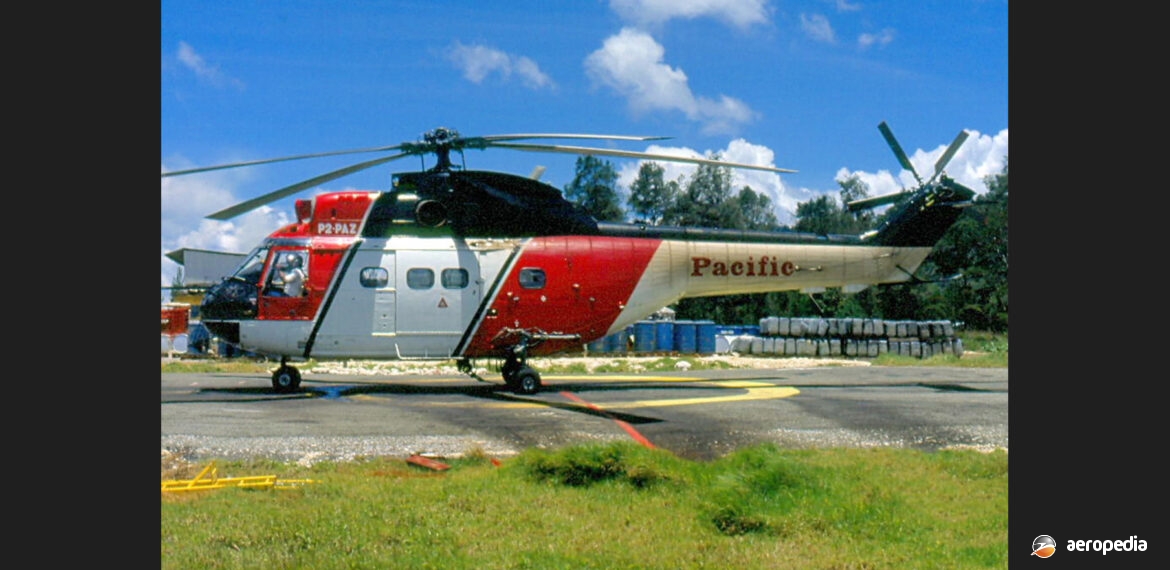Photograph:
Aerospatiale SA-330 Puma P2-PAZ (c/n 1459) in New Guinea (Nigel Apperley)
Country of origin:
France
Description:
Medium-lift utility helicopter
Power Plant:
Two 1,175-kw (1,575-shp) Turbomeca IVC turboshafts
Specifications:
- Rotor diameter: 15.08 m (49 ft 2 ½ in)
- Fuselage length: 14.06 m (46 ft 1 ½ in)
- Height: 5.14 m (16 ft 10 in)
- Max speed: 262 km/h (163 mph)
- Max continuous cruising speed at sea level: 257 km/h (159 mph)
- Max inclined rate of climb: 426 m/min (1,400 ft/min)
- Hovering ceiling in ground effect: 2,230 m (7,315 ft)
- Max range with standard fuel: 550 km (342 miles)
- Empty weight: 3,615 kg (7,969 lb)
- Loaded weight: 7,500 kg (16,534 lb)
History:
The Puma series of helicopters was designed and developed by the National Aerospatiale Company in France in the early 1960s to meet a requirement of the French Army for a medium-lift, twin-engine, helicopter. In this role the Puma could accommodate a crew of two and sixteen troops.
The prototype was flown for the first time on 15 April 1965 powered by 1,268-kw (1,700-shp) Turbomeca Makila turboshafts, and the type was immediately ordered for the French Army, with the first production batch being known as the SA 330B. After discussions with the British Government, the Puma then became one of three helicopters included in an Anglo-French co-production agreement, and the type entered service with the British Army. This model became known as the SA-330E, and differed only slightly from the French model. Both models, the SA 330B and 330E, were powered by two 991-kw (1,328-shp) Turbomeca Turmo III C4 turboshafts.
The Puma was also developed for the civil medium-lift role, and the prototype of this model, the SA 330F, fitted with two 1,175-kw (1,575-shp) Turbomeca IVCC turboshafts, was flown for the first time on 26 September 1969. The SA 330F was marketed mainly in the passenger role, and could carry a crew of two and sixteen passengers. It has seen work with commuter airlines, and with oil companies for off-shore oil-rig work; or with eight to twelve passengers in the VIP role. In the civil cargo role the SA 330C, a special freight variant, could lift 3,000 kg (6,600 lb) under the fuselage on an internally mounted sling. This variant had Turmo III C4 turboshafts, and was later replaced on the production line by the 330G with Turmo IVC engine.
Further development led to the SA 330G, the 330J for the passenger role, and the 330L, another cargo variant, which had newer technology main rotors of composite construction and a higher certificated gross weight. The type has been very popular around the world, and a number have been operated in this region on off-shore oil rig work by Bristow Helicopters, a British company, and Lloyds Helicopters. Aircraft registered include SA 330Js: VH-BHO (c/n 1526) registered in January 1979 and exported to Malaysia as 9M-SSI in January 1981. It later returned as VH-WOA (ex 9M-SSI, G-BFSV, VH-BHO, G-PFSV). Others have included VH-WOB (c/n 1472 – ex-G-BERG); VH-WOC (c/n 1475 – ex –G-BERI); VH-WOD (c/n 1478 – ex G-BFEU); and VH-WOF (c/n 1508 – ex G-BFKZ).

